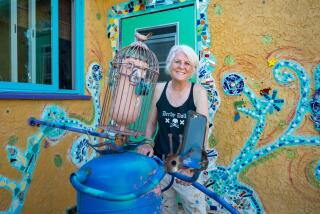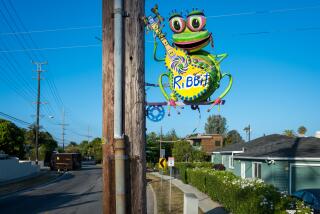It’s Still There : Artist Gets Extension on Removal of Controversial ‘Moon Dial’ Sculpture
- Share via
Halloween has come and gone, but “Moon Dial” remains to haunt Beverly Hills.
Looming over a strip of parkland like so many rusty pumpkins on poles, the lampooned public sculpture had faced an Oct. 31 city-imposed deadline for removal.
But Beverly Hills officials who led a crusade against the artwork have agreed to delay the inevitable, allowing it to remain until late November, when the artist will be required to cut its winch, two window grates and five old buoys from their concrete moorings.
It’s not that anyone has grown more fond of “Moon Dial,” but rather that artist George Herms was not able to cart it away on time.
“It’s going to be moved. You can bank on it,” said Ellen Byrens, chairwoman of the Fine Art Committee.
Herms created the work at the invitation of the city’s Fine Art Committee, an appointed group whose members thought that one of his assemblages would be just the thing for the intersection of Santa Monica Boulevard, Beverly Boulevard and Palm Drive.
But the work drew hundreds of complaints, and City Councilman Allan L. Alexander said last month that he hoped to celebrate the removal of “Moon Dial” on Oct. 31, the short end of its 18- to-36-month loan period.
During the controversy, the City Council asked Herms last year to remove the work before 18 months were up, but he refused. Recently, Alexander and Councilwoman Vicki Reynolds instructed the Fine Art Committee to tell Herms that his time was up.
City staffers said that they have been in contact with Herms and that he has promised to have it out by the end of the month.
“It’s not that it’s not art,” Alexander said. “The ‘Moon Dial’ represents and is intended to represent decay, and that’s not art that is appropriate for that location.”
“Moon Dial” is located in a narrow, carefully landscaped park at the eastern end of Beverly Hills. Herms has said that its rusting metal, a theme in many of his works, is intended to illustrate how man’s achievements are vulnerable to forces of time and nature.
Other loaned sculptures now on display along Santa Monica Boulevard may not be much better--one looks like a giant rearing cricket of colorful confetti, another like a “happy face” on a watermelon slice.
But they are not controversial.
“Not everyone may love it (the melon), but it doesn’t create the extreme contrast to the beautiful setting that the ‘Moon Dial’ does,” said Alexander, one of two City Council members named to oversee public art after Herms’ work was unveiled to a cacophony of protest last April.
Ken Fuher, a young artist, staged a sympathy demonstration of one in front of the “Moon Dial” last month, but the objections have not subsided. Actress Yvette Mimieux, a Bel-Air resident, called it a junk heap.
“Let the idiots . . . who wanted it made live with it in their own back yards,” she said in a letter to The Times.
The artist himself said that he was not able to remove his creation by the Halloween deadline because he was out of the country for much of October. And besides, he does not have anyplace to put it, he said. But he is looking for a new site.
“It’s difficult when the piece was made for that exact location to begin to shop it around,” he said.
Herms’ commercial work sells for between $5,500 and $30,000, said Jon E. Sorenson of L.A. Louver, the Venice gallery that represents him.
But Herms said that he has no plans to sell “Moon Dial,” which he put together from objects scrounged from a junkyard in El Monte and a marine salvage yard in Wilmington.
He plans to offer it to the city as a permanent gift, he said. If that is turned down, he will have it photographed and present the picture instead. Herms said it would be a memorial to the late George Slaff, a former mayor who spoke up for “Moon Dial” when the controversy erupted last year.
“There’s a lot of repression around, a lot of politicians wanting to censor the arts. The ones on our side who want to stand up for First Amendment rights should be honored,” Herms said.
Herms, 54, has had many exhibitions and received several federal grants. One of his earliest pieces, called simply Love, consists of an old leather pouch, a chain, a crucifix and a rusty film spool in a plain box. It dates from 1962.
A recent work, Guitar Burst, is made of an old guitar crushed by a star-shaped wall clock.
“People find his work very hard to deal with, but he’s considered to be one of the most important members of the Assemblage movement,” Sorenson said.
“His strength is transforming what people throw away into really beautiful objects.”
More to Read
Sign up for Essential California
The most important California stories and recommendations in your inbox every morning.
You may occasionally receive promotional content from the Los Angeles Times.













